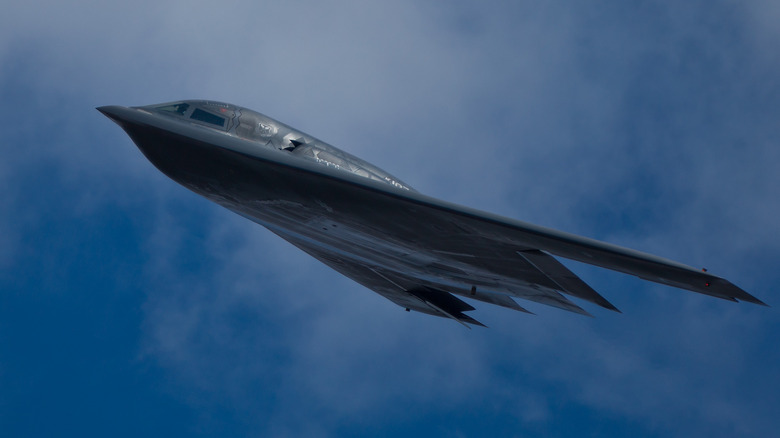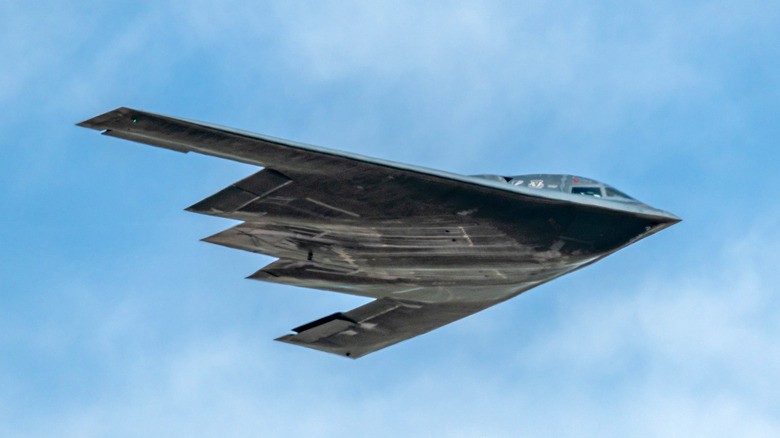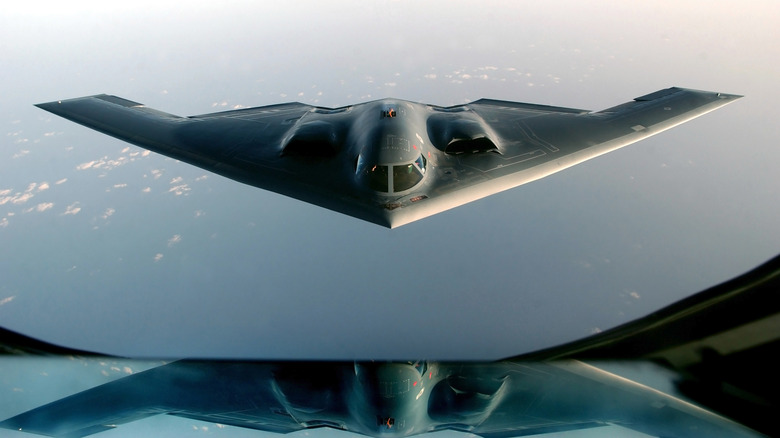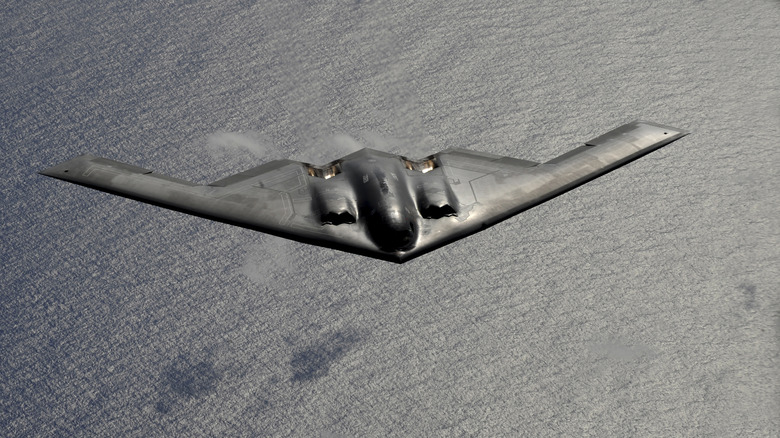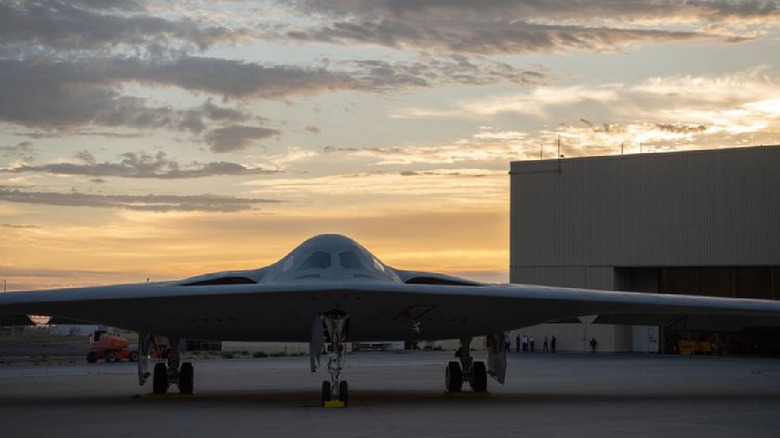Here's Why The B2 Bomber Cost More Than Any Plane Ever Built
When most people hear about expensive military planes, their immediate thought goes to the F-35 Lightning II. The price tag for the entire F-35 program is what made it so controversial, after all, coming in at $1.7 trillion over the span of 60 years. That's the cost of the program as a whole, however. Each individual F-35 comes in around $110 million, which is (technically and relatively speaking) reasonably priced for something as advanced as the Lightning II. While still pricey, it's nowhere near the cost of a single B-2 Spirit stealth bomber because the B in B-2 might as well stand for "billion."
The cost to manufacture a single B-2 bomber is $2.13 billion. That's billion with a "B," making it the single most expensive aircraft ever built. Of course, you don't spend over $2 billion and not create one of America's best stealth bombers. The B-2 Spirit was developed near the end of the Cold War, with its development beginning in 1987. It finally became operational in 1997, six years after the fall of the Soviet Union. Not being operational for any missions during the exact campaign it was designed for received hefty criticism from members of Congress, who were already upset about the bomber's price tag.
Rebecca Grant, a B-2 and aerospace expert who has flown in the bomber, told CNN, "It is really one of a kind, completely unlike any other plane ever designed." But does that warrant the high price to produce this aircraft? Exactly what makes it so expensive?
Just how stealthy is the B-2?
To this day, no B-2 Spirit has flown within Russian airspace. But if it had, it would have been quite the secret weapon. Unlike its cousin, the F-117 Nighthawk stealth fighter, the B-2 consisted of smooth, round angles and lacked any vertical designs like a tail, which are potential giveaways that a plane is flying nearby. Instead, its smooth features and radar-absorbing coating scatters radar waves, sending back a signature no bigger than a bird.
Furthermore, the designers tucked its engines away into the fuselage, not only hiding the flame from its afterburners but also minimizing its heat and sound signature. The B-2 is quiet enough that anyone nearby won't hear it until it has passed by overhead. The bomber's on-board system has a bevy of advanced controls that are classified to the general public, such as a process called PEN (Penetrate Enemy Defenses). This is an unspecified series of tasks the plane has to undergo before nearing an enemy, which begins when the pilot presses the PEN button.
Additionally, the bomber alerts the crew if it's producing vapor trails at all. When this happens, the pilot has to adjust their altitude to eliminate any visible sign that the B-2 is around.
Combat capabilities
The B-2 Spirit was initially designed to carry and drop nuclear gravity bombs on the Soviet Union. However, since its production wasn't finished until after the fall of the USSR, engineers modified it to carry a combat load of 20 tons, heavier than the B-52 Stratofortress, one of the largest airplanes in the world.
The B-2 can be stationed anywhere in the world and reach its target anywhere else on the planet without stopping. Its first operational flight saw two B-2s fly from Whiteman Air Force Base in Missouri to Kosovo, a 31-hour flight. It requires midair refueling, but the bomber is no stranger to flying near 70 hours at a time. Similar to a semi-truck, there is a space in the cockpit behind the crew seats where the pilots can rest in shifts during long flights.
Furthermore, when other bombers have to cancel their missions due to poor weather, the B-2 Spirit is still fully capable of operating. It was designed to fly higher than other bombers, allowing it to get above inclement weather and drop its bombs with impeccable accuracy. 33% of the Serbian targets destroyed in the Kosovo War were destroyed by B-2 bombers.
Regular upkeep
The design for the B-2 started in the '70s and had its maiden flight in 1989. Technology back then wasn't what it is now, meaning there has been plenty of work to modernize these bombers throughout the years. With the aircraft's high cost, the government slashed its initial order of B-2s from 132 down to 21. Even with only a handful of Spirits in active duty, it's not a cheap plane to update.
Northrop Grumman, the manufacturer of the B-2, has kept details of the flight instruments inside the cockpit rather close to its chest, releasing few pictures throughout the entirety of the program, but it's unlikely each bomber still uses the same programming and technology from the 1980s. Each jet has been stripped and refitted with the newest technology available at least once.
Shaugn Reynolds, vice president and B-2 program manager for Northrop Grumman Aeronautics Systems, told Popular Mechanics, "One item we are currently modernizing is the cockpit, by replacing the cathode ray tube monitor-based subsystem." These upgrades, on top of more advanced radar absorbent materials, digital systems and software, and updated avionics, are costing around $1 billion.
Future of the B-2 Spirit
As stated, the B-2 is currently undergoing further upgrades to keep it in the air. Along with updated avionics and stealth materials, it will also be armed with conventional and nuclear-tipped payloads when Raytheon's LRSO (Long-Range Stand Off) missile comes online. However, the Air Force won't be able to upgrade the B-2 indefinitely. Eventually, a new stealth bomber with a more advanced platform will have to take its place — something that's future-proof. That's why the Air Force has requisitioned a next-generation bomber from Northrop Grumman to fill the same role as the B-2 Spirit.
The B-2's eventual replacement will be the B-21 Raider, the world's first sixth-generation aircraft that should be significantly cheaper to produce than the B-2. It will keep the flying wing design that has made the B-2 so iconic. However, the Air Force intends to purchase 100 Raiders initially, significantly more than the 21 it bought of the Spirit. Being smaller and lighter along with having upgradeable systems will keep its costs significantly lower than its predecessor.
